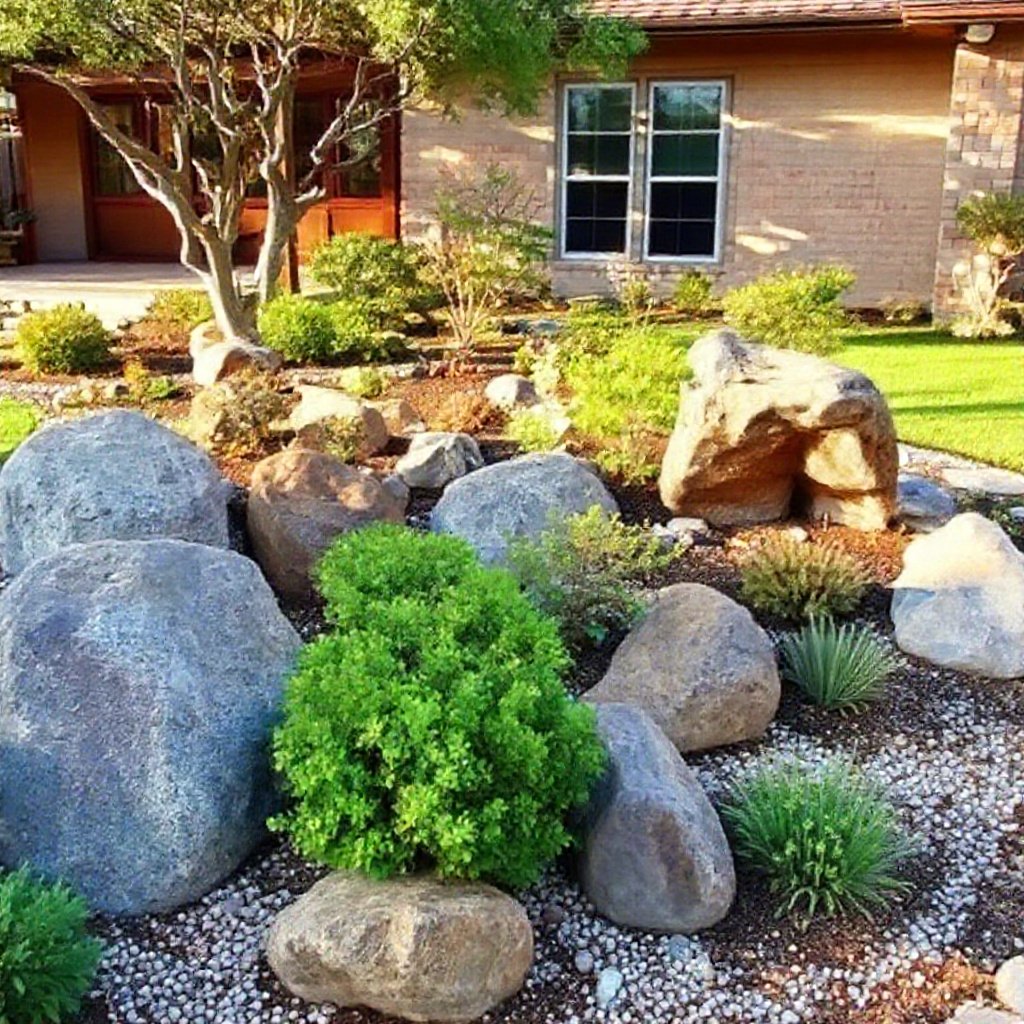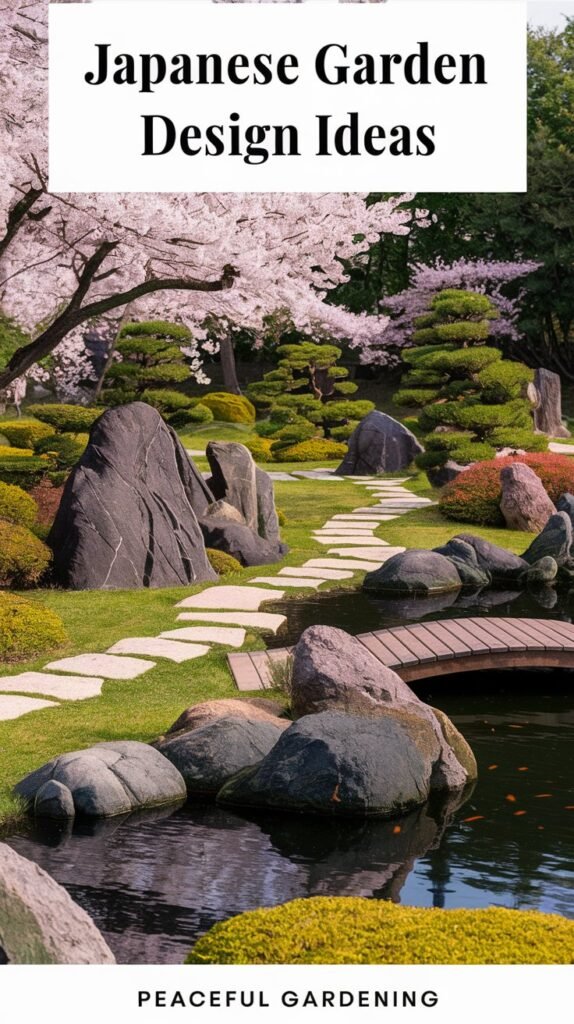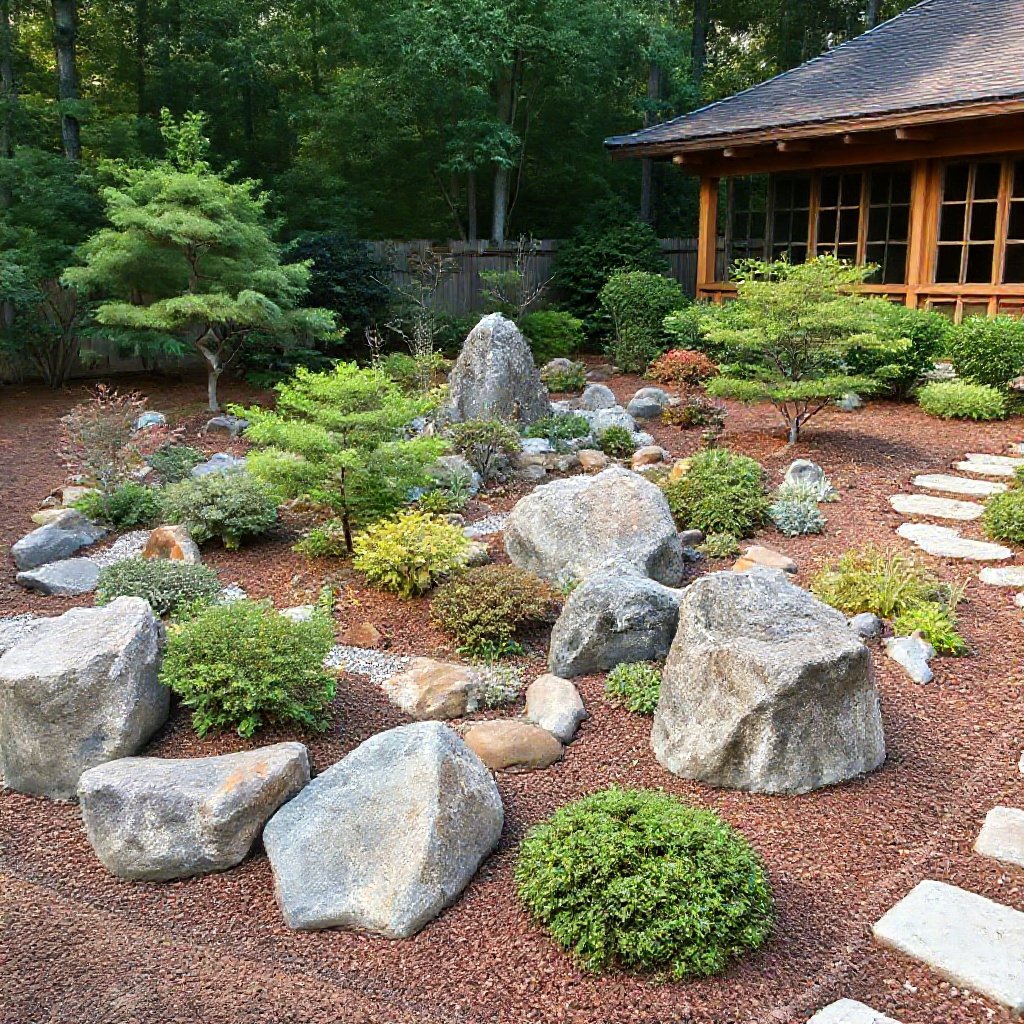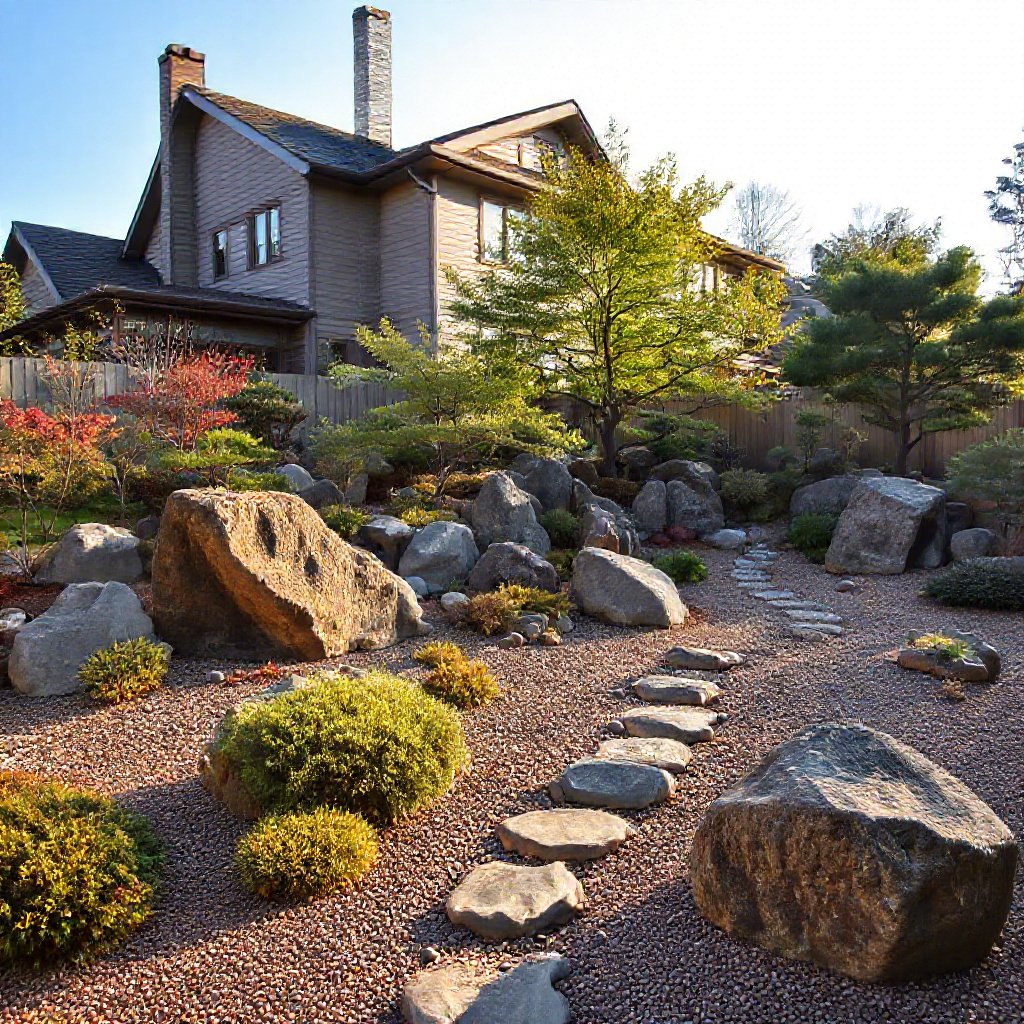Introduction to Zen Gardens
What is a Zen Garden
Ever find yourself mesmerized by the calm and simplicity of a Zen garden? I sure do. But what exactly is a Zen garden? Also known as Japanese rock gardens or karesansui, these spaces are meticulously designed to be peaceful and meditative (Source A). Think of them as nature’s way of giving you a big, calming hug. They usually feature rocks, sand, and gravel arranged in a way that invites you to sit, breathe, and just be (Source B).
Zen gardens are all about keeping it simple and beautiful. The rocks, the raked sand, and the plants are all placed just so, creating a space that feels balanced and harmonious. It’s like a visual poem that whispers peace and tranquility.
Benefits of Zen Gardens
Creating and looking after a Zen garden isn’t just about having a pretty space. It’s like a mini-vacation for your mind and body. One of the biggest perks? Stress reduction. The clean, simple design helps to calm your mind and lower stress levels (Source C). Raking the sand and arranging the rocks can be a meditative practice, helping you stay in the moment and forget about your worries.
Another awesome benefit is mindfulness. The garden’s simplicity encourages you to slow down and really notice the beauty around you (Source D). This mindful approach can boost your mental well-being and give you a sense of inner peace.
Here’s a quick rundown of the benefits:
| Benefit | Description |
|---|---|
| Stress Reduction | The calm design helps to soothe your mind and reduce stress. |
| Mindfulness | Encourages you to focus on the present, promoting mental clarity. |
| Meditative Practice | Activities like raking sand and arranging rocks can be meditative. |
| Aesthetic Beauty | Creates a visually pleasing space that enhances your environment. |

If you’re itching to bring some Zen into your garden, check out our other articles on zen garden landscaping, japanese garden lanterns, and small japanese garden ideas for more inspiration.
Elements of Japanese Garden Design
Creating a peaceful Zen garden isn’t rocket science, but knowing the basics of Japanese garden design can make all the difference. Let’s break down three key parts: rock garden features, water features, and plant selection.
Rock Garden Features
Rock gardens, or “karesansui,” are the bread and butter of Japanese garden design. These dry landscapes use rocks to symbolize mountains, islands, and rivers—no water needed. The way you place these rocks is crucial for creating that perfect balance.
Key Features:
- Main Rocks: Big, bold, and the stars of the show.
- Supporting Rocks: Smaller stones that play a supporting role.
- Gravel or Sand: Acts like water, raked into patterns to mimic its flow.
Common Arrangements:
- Triangular Formation: Think stability and balance.
- Horizontal Layout: All about calm and tranquility.
Need some rock-arranging tips? Check out my guide on zen garden landscaping.
Water Features
Water features are the heart and soul of many Japanese gardens. They symbolize renewal, calm, and the flow of life. Whether it’s a pond, stream, or waterfall, water adds a soothing sound that can turn any garden into a sanctuary.
Types of Water Features:
- Ponds: Often home to koi fish, symbols of strength and perseverance.
- Streams: Small, winding streams that snake through the garden.
- Waterfalls: Represent life’s flow, usually made with a series of rocks.
Benefits:
- Sound: The gentle trickle of water can melt away stress.
- Aesthetics: Reflects nature’s beauty and boosts the garden’s visual appeal.
Want to add water to your garden? Visit my section on japanese garden water features.

Plant Selection
Plants are the unsung heroes of Japanese garden design. They bring seasonal beauty and set the garden’s mood. Choose plants wisely, focusing on simplicity and natural charm.
Common Plants:
- Evergreens: Pine and bamboo, symbols of longevity and resilience.
- Flowering Plants: Cherry blossoms and azaleas for a splash of seasonal color.
- Ground Covers: Moss and ferns, creating a lush, green carpet.
Plant Characteristics:
- Texture: Mix it up to add depth and interest.
- Color: Stick to greens with seasonal pops of color.
- Form: Consider each plant’s natural shape and growth habit.
Need help picking plants? Check out my article on small japanese garden ideas.
By weaving these elements into your garden, you’ll create a space that screams tranquility, simplicity, and harmony. Whether you’re working with a sprawling yard or a tiny corner, these Japanese garden design tips will help you craft a serene and peaceful retreat.
Creating Tranquility in Your Garden
Turning your garden into a peaceful haven is all about keeping things simple and natural. Here are some Japanese garden design ideas to help you create a serene space.
Minimalist Design Tips
Minimalism is at the heart of Japanese garden design. It’s about making a calm space with just enough elements to bring peace without overloading the senses. Here are some tips to nail that minimalist vibe:
- Keep It Simple: “Less is more” is your mantra. Ditch the clutter and unnecessary decorations. Focus on a few key pieces that create harmony.
- Use Natural Materials: Go for materials like stone, wood, and bamboo. They blend right in with the natural surroundings.
- Choose Subdued Colors: Stick to a neutral palette with greens, browns, and grays. Bright colors can be jarring and mess with the calm.
- Create Open Spaces: Leave some areas open for contemplation and relaxation. These empty spaces are just as important as the filled ones.
For more minimalist design tips, check out our page on small Japanese garden ideas.
Adding Natural Elements
Nature is a big deal in Japanese garden design. Bringing natural elements into your garden can boost its tranquility and beauty:
- Rocks and Stones: Use rocks to give a sense of permanence and stability. Arrange them in natural, uneven patterns to mimic nature.
- Water Features: Water stands for life and continuity. Whether it’s a small pond or a simple water basin, the sound of water adds to the peaceful vibe. Check out our guide on Japanese garden water features for more ideas.
- Plants and Trees: Pick plants that are native to your area to make your garden more sustainable. Bamboo, moss, and evergreens are popular choices in Japanese gardens.
- Natural Light: Make sure your garden gets plenty of natural light. The play of light and shadow can create a dynamic and ever-changing scene.
Example Table: Common Natural Elements in Japanese Gardens
| Element | Description |
|---|---|
| Rocks | Symbolize permanence and stability. Often used in asymmetrical arrangements. |
| Water Features | Represent life and continuity. Includes ponds, streams, and water basins. |
| Plants | Native species like bamboo, moss, and evergreens. |
| Natural Light | Enhances the garden’s dynamic and tranquil atmosphere. |

Adding these natural elements can turn your garden into a peaceful retreat. For more inspiration, explore our resources on zen garden landscaping.
By following these minimalist design tips and adding natural elements, you can create a serene and tranquil garden space that captures the essence of Japanese garden design.
Japanese Garden Styles
Karesansui (Dry Landscape)
Karesansui, or rock gardens, are a staple in Japanese garden design. Often found at Zen temples, these gardens are all about peace and contemplation. Picture this: carefully arranged rocks, gravel, and sand, raked into patterns that mimic rippling water. No water features, no fuss—just pure, simple beauty.
I adore the calm these gardens bring. They’re low-maintenance since they don’t need water features or a ton of plants. The magic lies in their minimalism, creating a meditative space with just a few natural elements.
If you’re curious to learn more, check out Wybe Kuitert’s book, “Karesansui: The Japanese Rock Garden”. It’s a deep dive into the history and aesthetics that make these gardens so special.
Tsukiyama (Hill Gardens)
Tsukiyama, or hill gardens, are like mini natural landscapes. Think rolling hills, ponds, streams, and carefully chosen plants. These gardens often recreate famous landscapes, giving you a scenic view in a small space.
What blows my mind about Tsukiyama gardens is their use of perspective. By placing stones, water features, and plants just right, they create an illusion of depth and scale, making a tiny area feel much bigger.
If you’re thinking about creating a Tsukiyama garden, Alvin Horton’s book, “Creating Japanese Gardens”, is packed with practical advice and inspiration. Sophie Walker’s “The Japanese Garden” is also a must-read for understanding the history and culture behind this garden style.
Chaniwa Gardens
Chaniwa gardens, or tea gardens, set the stage for the Japanese tea ceremony. These gardens focus on simplicity, natural beauty, and tranquility. You’ll often find stepping stones, lanterns, and water basins, all arranged to guide guests to the tea house.
I find Chaniwa gardens enchanting because they create a serene atmosphere perfect for the mindfulness and ritual of the tea ceremony. The layout is designed to slow you down and encourage reflection.
For a deeper dive into Chaniwa gardens, Marc Peter Keane’s book, “The Art of Setting Stones: And Other Writings from the Japanese Garden”, is a great read. Seiko Goto and Takahiro Naka’s “Japanese Gardens: Symbolism and Design” also offers a comprehensive look at the elements and philosophy behind these gardens.
Creating a Japanese garden is a rewarding way to bring tranquility into your home. For more inspiration and practical tips, check out our articles on zen garden landscaping, small japanese garden ideas, and japanese garden water features.
Practical Zen Garden Ideas
Creating a Zen garden is all about simplicity and peace. Here are some easy ideas to bring Zen vibes to your garden.
Raking Patterns
Raking patterns, or Karesansui, aren’t just for looks. They mimic water flow and bring a sense of calm.
- Parallel Lines: Think of still water, bringing peace.
- Circular Patterns: Like ripples around stones, symbolizing islands.
- Waves: Mimic gentle waves, adding a dynamic yet soothing touch.
These patterns can change the whole feel of your garden. For more on raking, check out Zen Garden Raking Techniques.
Stone Arrangements
Stones are a big deal in Japanese gardens, symbolizing mountains, islands, and more. Their placement is key.
- Tall Vertical Stones: Think mountains or trees.
- Flat Horizontal Stones: Represent water or land.
- Arching Stones: Often symbolize bridges.
When placing stones, think about their size, shape, and texture. They should feel natural and balanced. For tips, visit Stone Placement in Japanese Gardens.
Symbolic Elements
Adding symbolic elements can boost your garden’s tranquility and meaning.
- Lanterns: Represent light and guidance. Learn more at Japanese Garden Lanterns.
- Bridges: Symbolize journeys and change.
- Water Features: Stand for purity and calm. For ideas, visit Japanese Garden Water Features.
Place these elements thoughtfully to create a harmonious space. For more on symbolism, explore Meaning Behind Symbolic Elements in Zen Gardens.
By using these ideas, you can create a peaceful and mindful garden that reflects the beauty of Japanese design. For more inspiration, check out our section on small japanese garden ideas.
Keeping Your Zen Garden Serene
Taking care of a Zen garden isn’t just about routine maintenance; it’s about embracing a mindful approach that aligns with Zen principles. Let’s dive into how to keep your Japanese garden looking its best through seasonal care, pruning, and mindful practices.
Seasonal Care
Keeping your Zen garden beautiful year-round means paying attention to the unique needs of each season. Here’s a quick guide to what you should be doing:
| Season | Tasks |
|---|---|
| Spring | Plant new greenery, clear debris, refresh raking patterns |
| Summer | Water regularly, trim overgrown plants, maintain water features |
| Fall | Rake leaves, prep plants for winter, check stone arrangements |
| Winter | Protect plants from frost, reduce water usage, clear snow from paths |
For more detailed tips, visit ZenGarden.com.
Pruning Techniques
Pruning is key to keeping your Zen garden’s minimalist and serene vibe. Here’s how to do it right:
- Selective Pruning: Cut away dead or diseased branches to encourage new growth.
- Thinning: Remove extra branches to let light and air reach the plant.
- Shaping: Trim plants to keep their natural form, enhancing the garden’s harmony.
Learn more about pruning at ZenGardenCare.com.
Mindful Garden Practices
Turning garden chores into a meditative practice can make maintaining your Zen garden a peaceful experience. Here’s how:
- Mindful Raking: Focus on the patterns you create in the sand or gravel, letting the repetitive motion calm your mind.
- Meditative Pruning: Prune with intention, paying attention to each cut and the overall shape of the plant.
- Presence in Nature: Spend time just being in your garden, observing the natural elements and soaking in the tranquility.
For more on mindful gardening, check out MindfulGardening.com.
Keeping a Zen garden is an ongoing journey that invites you to connect with nature and find peace. By following these seasonal care tips, pruning techniques, and mindful practices, your Japanese garden will remain a serene sanctuary. For more ideas on enhancing your garden, explore our articles on zen garden landscaping and japanese garden water features.

My name is Michelle Warren, and I’m the founder of Peaceful Gardening. As a 10-year breast cancer survivor, I’ve discovered the profound therapeutic power of gardening. This journey has not only helped me recover but has also become my passion and a source of ongoing peace and joy.
Peaceful Gardening was born from my desire to share the healing benefits of gardening with others. Whether you’re facing health challenges, dealing with stress, or simply looking to connect more deeply with nature, this space is for you.
Over the past decade, I’ve cultivated not just plants, but a deep understanding of how gardening can positively impact mental health. I’ve worked with local community gardens, led workshops on mindful gardening practices, and collaborated with mental health professionals to develop gardening-based stress reduction programs.
Peaceful Gardening was born from my desire to share the healing benefits of gardening with others. Whether you’re facing health challenges, dealing with stress, or simply looking to connect more deeply with nature, this space is for you.
Here, you’ll find evidence-based advice on using gardening as a tool for mindfulness, stress relief, and emotional healing. I share personal stories, practical tips, and scientifically-backed information on how to create your own therapeutic garden space, no matter the size of your yard or balcony.
My mission is to help you discover the joy, peace, and healing that comes from nurturing plants and connecting with nature. Join me in exploring how the simple act of tending to a garden can transform your mental and emotional wellbeing.
Welcome to Peaceful Gardening – let’s grow together towards better mental health!”

